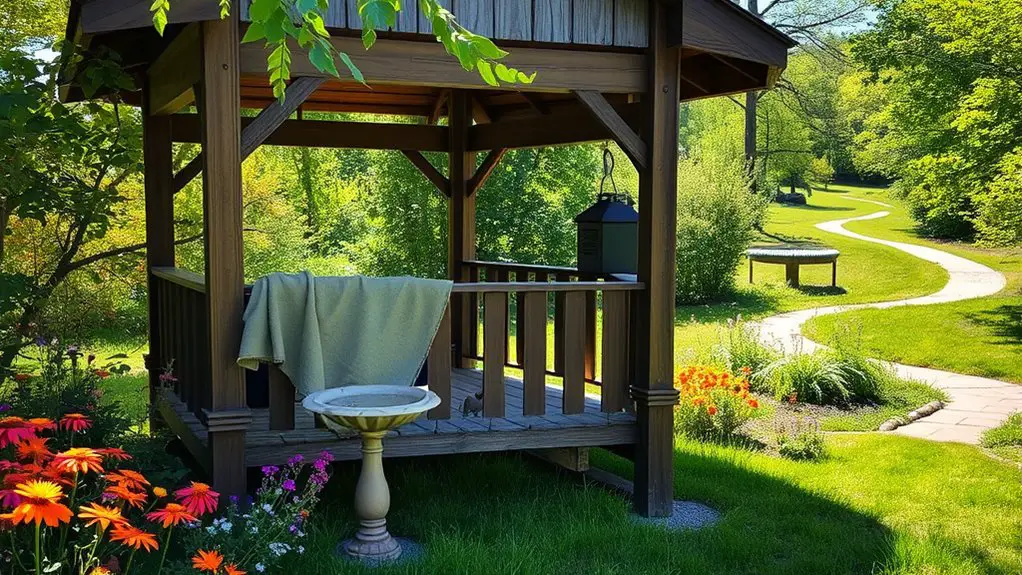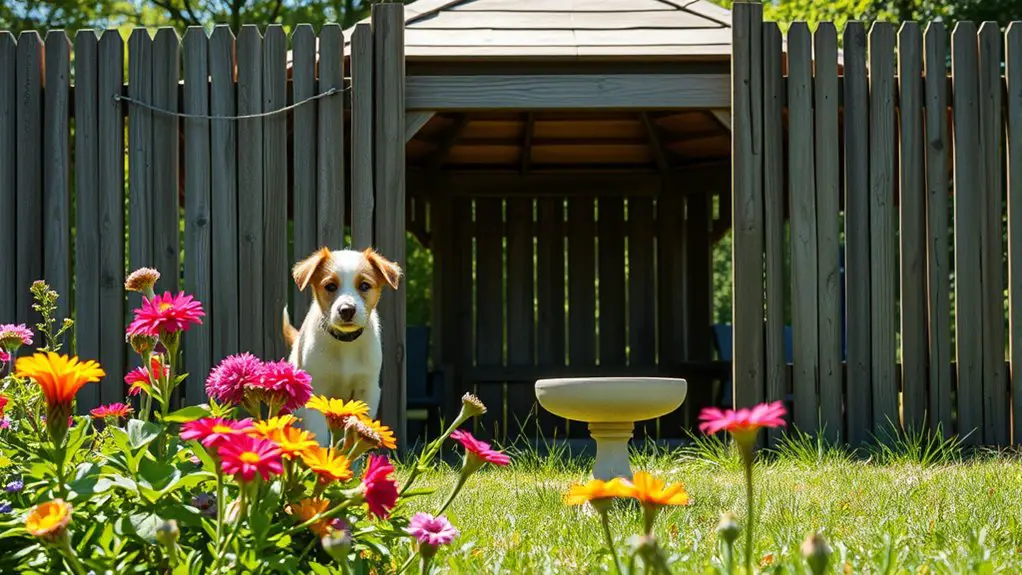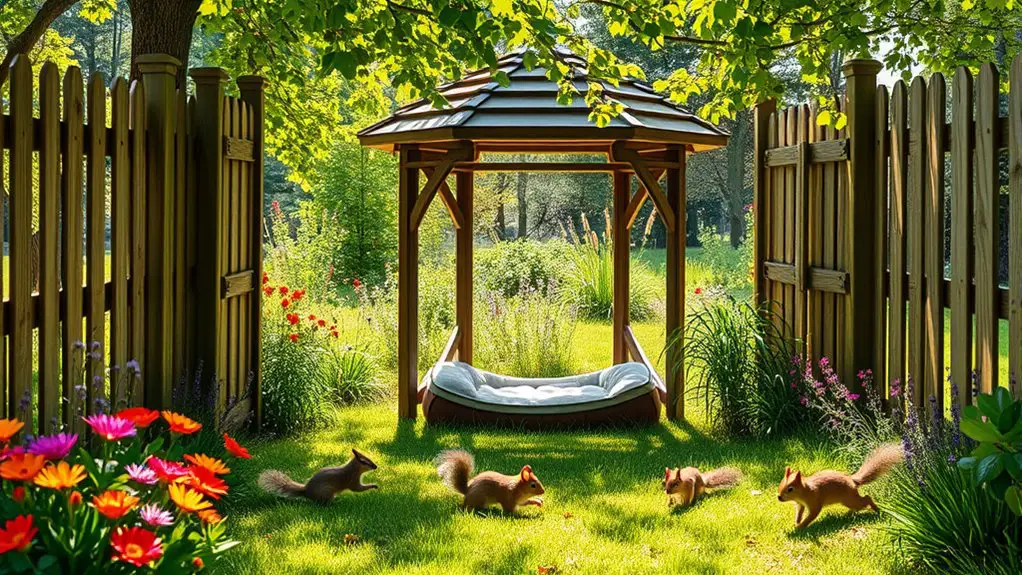Creating a safe space for your pets and local wildlife around your gazebo is all about thoughtful planning. Start by evaluating sunlight exposure and drainage, then choose pet-friendly plants like marigolds and mint. Installing sturdy fencing keeps pets secure, while providing fresh water sources benefits all. Designate play areas with soft surfaces for your pets’ comfort. By fostering respectful interactions between your pets and wildlife, you can achieve harmony in your outdoor space, and there’s much more you can explore.
Assessing Your Gazebo’s Location and Surroundings

When you’re considering the placement of your gazebo, it’s essential to think about its surroundings and how they impact both pets and local wildlife. Start by evaluating sunlight exposure; your pets will love a sunny spot for lounging, but too much sun can be harmful. Aim for a balance that provides shade during the hottest parts of the day. Additionally, consider the gazebo’s sun and shade exposure, as this will influence the comfort and safety of both your pets and local wildlife.
Next, assess drainage conditions. You want to avoid placing your gazebo in a low area where water can pool, creating a breeding ground for mosquitoes or muddy patches for your pets. Choosing a well-drained spot not only keeps your pets clean but also protects local wildlife.
Choosing Pet-Friendly Plants and Landscaping
Since your outdoor space is meant to be a haven for both pets and local wildlife, choosing the right plants and landscaping features is essential. Opt for pet-friendly flowers like marigolds, sunflowers, and zinnias that add color without harming your furry friends. These blooms not only brighten your gazebo area but also attract beneficial pollinators, enhancing biodiversity.
When it comes to herbs, consider planting safe options like basil, rosemary, and mint. These herbs are not only safe for pets but can also spice up your meals and provide natural scents that keep pests at bay.
Installing Fencing and Barriers

When it comes to keeping your pets and local wildlife safe, installing the right fencing and barriers is essential. You’ll want to reflect on various types of fencing that suit both your space and your animal’s needs, while also following some simple installation tips for effectiveness. By taking these steps, you’re not just protecting your pets—you’re also creating a harmonious environment for wildlife.
Types of Fencing
While creating a safe environment for your pets and local wildlife, choosing the right type of fencing is essential. You have options like wooden fencing, which provides a sturdy, natural look, or wire fencing, ideal for keeping smaller animals contained while maintaining visibility. Each type serves different needs, so consider what fits your space best.
| Type of Fencing | Pros | Cons |
|---|---|---|
| Wooden Fencing | Aesthetic appeal, sturdy | Can rot, requires maintenance |
| Wire Fencing | Durable, lightweight | Less privacy, visibility |
| Vinyl Fencing | Low maintenance, versatile | Can be costly |
| Electric Fencing | Effective deterrent | Requires power source |
| Chain Link Fencing | Affordable, strong | Limited privacy |
Choose wisely to balance safety and aesthetics!
Barrier Installation Tips
Before diving into the installation process, it’s essential to plan thoroughly to guarantee your fencing or barriers provide the safety you desire for your pets and local wildlife. Start by choosing the right fence materials—wood, vinyl, or metal—based on durability and aesthetic appeal. Don’t forget to contemplate the height and spacing to keep your pets secure while allowing wildlife to thrive. Once installed, regular barrier maintenance is key; check for wear and tear, and make repairs promptly to maintain safety. Remember, these barriers are not just for protection; they create a harmonious environment for your pets and local creatures. Take the time to ascertain your space is both secure and welcoming, allowing everyone to enjoy their freedom.
Providing Shelter and Water Sources
Creating a welcoming environment for both pets and wildlife means ensuring they have access to safe shelter and fresh water. Consider various shelter options, like small wooden huts for pets or natural features like bushes and trees for wildlife. These safe havens provide protection from harsh weather and predators, allowing your furry friends and local critters to thrive.
Water sources are just as essential. Providing a simple bowl for your pets is an easy fix, while a shallow dish can attract birds and other wildlife. Make sure to change the water regularly to keep it fresh and appealing.
Creating Safe Play Areas for Pets

To guarantee your pets enjoy their playtime safely, it’s important to design designated play areas that minimize risks and maximize fun. Start by choosing a spot near your gazebo where your furry friends can romp freely without danger. Enclose the area with a sturdy, pet-friendly fence to keep them secure while they’re engaged in their playtime activities.
Next, select safe toys made from non-toxic materials that withstand your pet’s excitement. Think durable balls, ropes, and interactive puzzles to keep their minds stimulated. Regularly inspect these toys for wear and tear to prevent accidents. Additionally, consider implementing anchoring techniques to secure your gazebo, ensuring that it remains a safe and stable environment for your pets during windy conditions.
You might also consider adding soft surfaces, like grass or rubber mats, to cushion any falls during their energetic play. Remember, creating a safe play area not only protects your pets but also allows you to relax and enjoy watching them thrive in their little paradise.
Attracting Beneficial Wildlife
While it might seem challenging to invite wildlife into your backyard, attracting beneficial creatures can enhance your outdoor space and contribute to a thriving ecosystem. Start by creating beneficial habitats—plant native flowers, shrubs, and trees that provide food and shelter. These plants not only attract pollinators like bees and butterflies but also support birds and small mammals.
Consider adding a water source, like a birdbath or small pond, to encourage visits from diverse wildlife. Establishing wildlife corridors through strategic landscaping can help these creatures navigate safely while exploring your yard.
Using Natural Pest Control Methods
When it comes to keeping pests at bay, you don’t have to rely on harsh chemicals that could harm your pets or local wildlife. Instead, natural repellents, companion planting, and encouraging beneficial insects can create a healthier, more balanced environment. By choosing these methods, you’re not just protecting your space—you’re fostering a thriving ecosystem.
Essential Natural Repellents
If you’re looking to protect your pets and local wildlife from pests without resorting to harsh chemicals, natural repellents can be a game changer. Embracing eco-friendly solutions not only guarantees a safe environment but also supports a healthy ecosystem. Here are three effective natural deterrents you can try:
- Essential Oils: Citronella, peppermint, and eucalyptus oils repel many pests. Mix with water and spray around your gazebo.
- Vinegar: A simple solution of vinegar and water can deter ants and spiders. Just wipe surfaces regularly.
- Coffee Grounds: Sprinkle used coffee grounds around your garden. They’re known to repel slugs and snails.
Companion Planting Techniques
Companion planting techniques can transform your garden into a thriving ecosystem, allowing you to harness nature’s power for pest control. By creating beneficial pairings, you can naturally deter pests while promoting healthy plant growth. For instance, planting marigolds alongside vegetables not only beautifies your space but also repels harmful insects. Consider pairing basil with tomatoes; the basil enhances the flavor of the tomatoes while warding off pests. These strategies not only reduce the need for chemical sprays but also create a balanced environment where your pets and local wildlife can coexist. Embracing companion planting gives you the freedom to nurture a garden that’s both safe and productive, all while enjoying the natural harmony of your outdoor space.
Encouraging Beneficial Insects
Creating a thriving garden isn’t just about the plants you choose; it’s also about fostering a welcoming environment for beneficial insects. By encouraging these tiny allies, you’ll promote natural pest control and enhance your pollinator gardens. Here are three easy ways to create insect habitats:
- Diverse Plant Selection: Incorporate a variety of flowering plants, herbs, and native species to attract different insects.
- Provide Shelter: Use logs, rocks, or brush piles to create cozy spots for insects to hide and thrive.
- Avoid Pesticides: Opt for natural alternatives that won’t harm your beneficial buddies, preserving the delicate balance of your garden ecosystem.
Educating Guests on Respecting Wildlife and Pets
While it’s easy to get caught up in the excitement of encountering wildlife or playing with pets, it’s essential to remember that these creatures deserve our respect and care. Practicing wildlife etiquette goes a long way in ensuring both guests and animals feel safe. When you educate your guests, remind them to observe wildlife from a distance, refrain from feeding them, and avoid loud noises that can startle or harm them.
Encourage your visitors to appreciate pets as companions, not playthings. Teach them to approach pets gently and always ask the owner for permission before petting. By fostering an environment of respect, you create a harmonious space for both pets and wildlife.
Ultimately, guest education is crucial for preserving the delicate balance between human enjoyment and the natural world. By sharing these principles, you empower everyone to enjoy their freedom while protecting the beautiful creatures around your gazebo.
Frequently Asked Questions
How Can I Keep My Pets Safe From Wildlife Around the Gazebo?
To keep your pets safe from wildlife, consider implementing pet safety measures like fences and supervision. Use wildlife interaction tips, such as noise deterrents or safe scents, to discourage unwanted encounters and guarantee a peaceful environment.
What Common Hazards Should I Remove From the Gazebo Area?
To guarantee a safe gazebo area, remove hazardous materials and sharp objects. You want your space to be free and enjoyable for everyone. A little effort now can prevent accidents and create peace of mind.
Are There Specific Plants Toxic to Pets I Should Avoid?
When planning your garden, it’s essential to prioritize toxic plant identification. Avoid plants like lilies and azaleas, choosing pet-safe landscaping options instead. Your pets deserve a safe, happy environment to explore and enjoy their freedom.
How Do I Discourage Unwanted Wildlife From Entering My Yard?
Think of a fortress protecting your domain. To discourage unwanted wildlife, consider solid fencing options and noise deterrents like motion-activated devices. These solutions help you maintain a peaceful haven while respecting the freedom of nature.
What Signs Indicate My Pets Are Stressed by Wildlife Presence?
You’ll notice signs of stress in your pets, like excessive barking, hiding, or destructive behavior. These changes often stem from wildlife interaction. Paying attention to their behavior can help you create a calmer environment for them.

